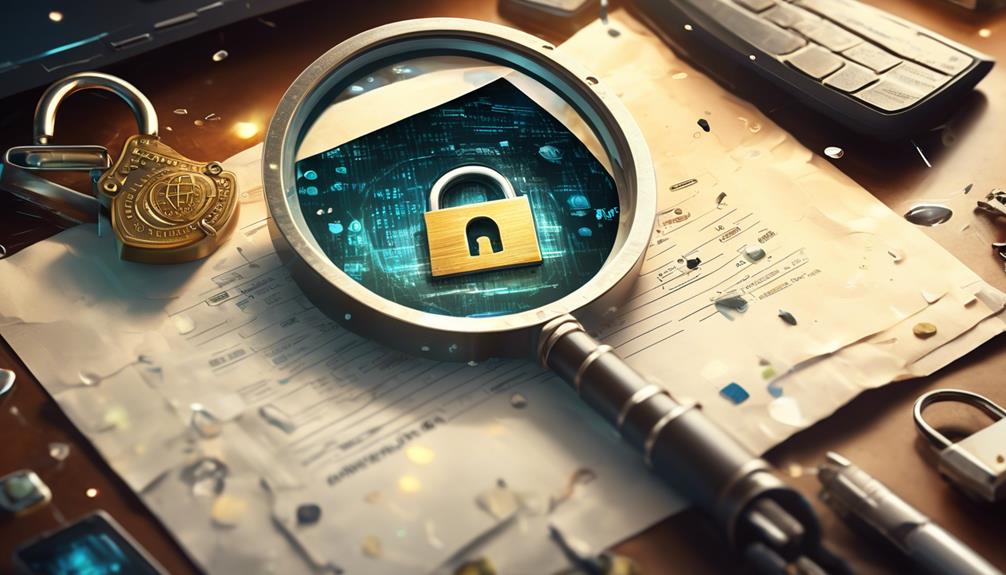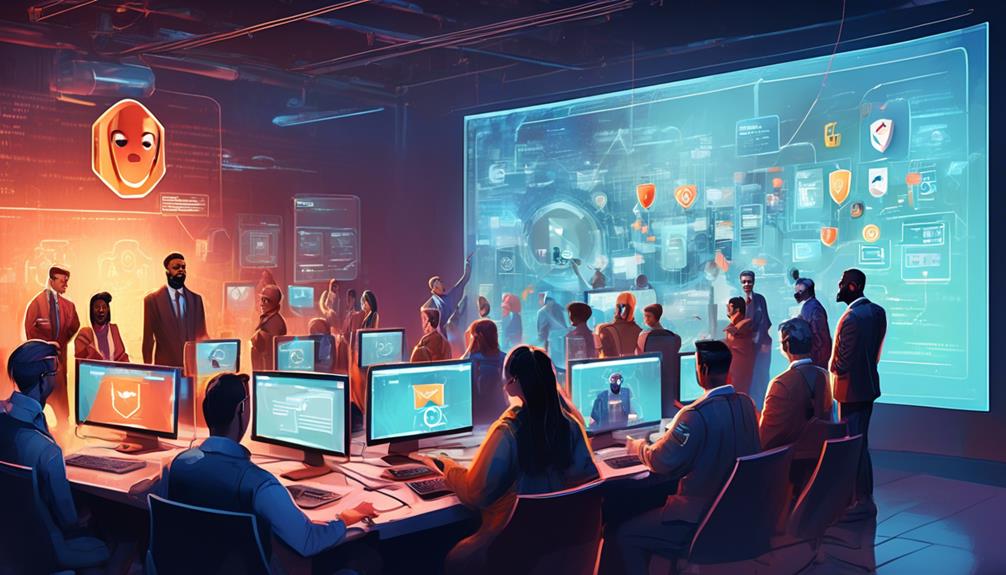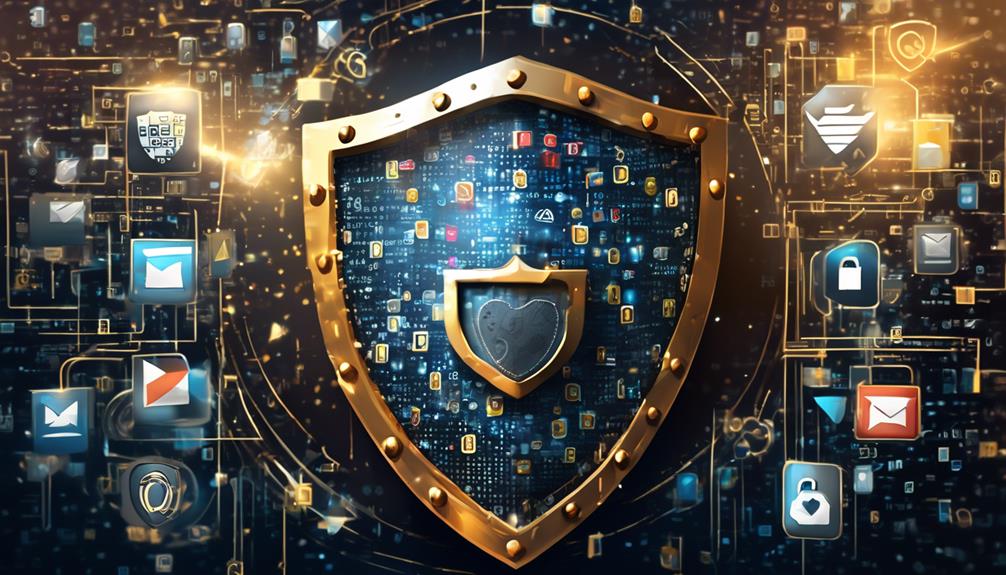In today's digital age, email is often chosen by supposed distant royalty to share wealth. Interestingly, our inboxes are now key cybersecurity battlefields. It's somewhat flattering that so many high-profile figures would trust strangers with riches. However, the prevalence of deceptive emails demands action from both companies and individuals.
They must equip themselves with knowledge and tools to identify and thwart these unsolicited deceptions. Carefully examining the sender's credentials is a critical first step. Analyzing an email for fraudulence signs is also vital. Implementing these steps can protect sensitive data or prevent a costly scam.
Cybercriminals are constantly refining their deceptive methods. Therefore, it's imperative to remain vigilant and proactive. The quest to learn effective cybersecurity measures is ongoing. Can you discern if your next email is from genuine royalty or merely a clever impostor?
Understanding Email Phishing

Email phishing is a deceptive practice. It aims to steal sensitive information by pretending to be a trusted entity. Typically, this occurs through electronic communication. These schemes exploit the victim's mindset, which tends to trust and feel safe in familiar digital environments.
Phishers use well-crafted tactics to manipulate this trust. They employ social engineering to provoke urgent or fearful responses. Attackers create emails that look like they're from reliable sources. These sources can be banks, social networks, or even coworkers. By creating a sense of urgency or fear, scammers encourage quick action. Consequently, this often leads to victims ignoring their usual caution.
Psychological manipulation is crucial for phishing attacks. It takes advantage of our need for security and belonging. When recipients believe they are protecting their place in a trusted group, they are more likely to respond.
To combat these methods, awareness is critical. Everyone in an organization must learn about phishing techniques. Indeed, technical defenses are necessary. However, they should be paired with knowledge of phisher strategies. This combination enables people in digital communities to identify and resist cybercriminal tactics. Ultimately, it helps protect individual data and the group's collective security.
Recognizing Suspicious Senders
In battling deceptive emails, users must scrutinize the sender's details. Firstly, they should inspect the email address and domain. Any discrepancies may indicate inauthenticity. Thus, establishing verification methods for email authenticity is essential. This helps to thwart successful phishing attempts.
Scrutinize Sender Details
To effectively guard against deceptive emails, it's essential to scrutinize the sender's details. Look for signs of suspicious activity. Carefully examining email addresses and display names is crucial. These might contain discrepancies that are easily overlooked.
Using email forensics is vital for this scrutiny. It allows users to analyze header information. Look for anomalies that suggest a sender's illegitimacy. Additionally, a community-focused approach is very important. It emphasizes the value of collective vigilance.
By sharing knowledge, we can recognize red flags, such as mismatched domain names. Or, we might find unexpected contact methods. Consequently, individuals can better defend against cyber threats. Everyone becomes more skilled at detecting forgeries. As a result, our group's resilience to deceptive tactics increases.
This collective effort leads to a secure digital space. Here, everyone can experience a sense of belonging and safety.
Verify Email Authenticity
Determining if an email is genuine typically involves spotting key indicators of fraud. Importantly, email encryption acts as a vital barrier. It protects genuine messages from unauthorized access. Additionally, a sender's reputation offers valuable clues about their reliability. This metric is based on their past email conduct. Consequently, it is essential for the community to focus on email verification. This effort will help guard against phishing and other harmful schemes.
Analyzing Email Content

Scrutinizing the content of an email is a crucial step in identifying deceptive messages that could threaten cybersecurity. Users must vigilantly examine email grammar and be wary of unusual requests, as these are common red flags of phishing attempts. Discrepancies in language, such as poor syntax or spelling errors, often indicate an email's lack of authenticity. Cybercriminals may not have the linguistic proficiency or time to craft a flawless message, exploiting urgency over accuracy to manipulate targets.
Unusual requests, especially those asking for personal information or immediate action, should trigger a cautious response. Legitimate organizations typically don't solicit sensitive data via email. If an email implores the recipient to bypass standard procedures, it's likely a scam. The community within a workplace should foster a culture of awareness and encourage reporting of suspicious emails. By sharing knowledge and experiences, members feel a sense of belonging and collective responsibility for the group's digital safety.
Analyzing email content isn't just about spotting mistakes; it's about understanding the tactics used by attackers. Therefore, continuous education on the latest phishing techniques is vital. As cyber threats evolve, so must the collective vigilance of an informed and interconnected community.
Verifying Links and Attachments
Users should diligently examine links, looking for phishing clues like mismatched URLs. Additionally, misspelled domain names are red flags. Furthermore, evaluating attachments is crucial; one should verify file types. Importantly, scanning with current antivirus software is a must. Adopting this vigilant stance lessens the chances of accidental malware activation or data breaches.
Spot Suspicious Link Indicators
Vigilance is essential when verifying link authenticity to prevent cyber threats. Practicing link hygiene is crucial, as it involves examining URL patterns closely. Look for subtle misspellings, unfamiliar domains, or unexpected redirects, as these can indicate danger. Before clicking, users should hover over links to preview their destinations. Additionally, they must avoid the urgency scammers often create to deceive. Observing the security of connections is important; look for HTTPS indicators. Email encryption is another critical defense layer. These steps help the community stay ahead of cyber adversaries. By doing so, we create a collective shield against deception. This effort fosters a secure atmosphere, thereby strengthening our shared digital space.
Analyze Attachment Safety
Link hygiene is crucial, and so is assessing email attachment safety. These attachments often carry malware or enable phishing. Consequently, scanning attachments is a primary defense for users. It allows the detection of malicious code before system compromise.
To perform this, specialized software is utilized. It meticulously examines each file for known threats. This ensures that only secure content is permitted. Furthermore, being aware of file types is vital for safety. Users should identify dangerous file types, like executables or scripts.
These can contain harmful code. By recognizing riskier file types, community members make safer choices. They avoid seemingly harmless downloads that could cause disruption. Hence, this collective caution strengthens the group's defense against deceptive emails.
Implementing Multi-Factor Authentication

One of the most effective defenses against unauthorized access via deceptive emails is the implementation of multi-factor authentication (MFA). By requiring multiple forms of verification, MFA significantly reduces the risk of compromised credentials leading to a security breach. Secure tokens and robust authentication policies form the cornerstone of a strong MFA framework. These tokens provide a physical or digital means of verifying a user's identity, complementing traditional password-based security with an additional layer of protection.
Organizations that prioritize MFA in their cybersecurity protocols ensure that even if a user's password is stolen through a phishing attempt, the attacker still can't gain access without the second factor. This could be a temporary code sent to a mobile device, a biometric factor like a fingerprint, or a security key.
Adopting MFA also means updating authentication policies to encompass all users and access points. It's not just about having the technology in place but also about creating a culture where every member understands and adheres to the security measures. This inclusive approach fosters a sense of belonging and collective responsibility for cybersecurity within the organization.
Updating Software Regularly
Updating software regularly is crucial for cyber defense against deceptive emails. Cybercriminals constantly exploit vulnerabilities, so users must stay vigilant. Consequently, integrating patch management into security protocols is essential. This strategy repairs flaws and strengthens systems against future attacks.
Here are three top reasons to prioritize software updates:
Firstly, updates patch critical vulnerabilities. They address security holes found since the last version's release. If updates are delayed, users risk exposure to attacks exploiting these weaknesses.
Secondly, updates guard against zero-day attacks. Cybercriminals quickly leverage unknown software flaws. Regular updates ensure the latest protections, mitigating risks.
Thirdly, updates maintain compliance standards. Often, they're required for industry regulation compliance. Non-compliance can result in penalties and loss of trust among peers and clients.
For those in the cybersecurity community seeking belonging, it's crucial to recognize our collective responsibility. Timely updates are a shared effort, protecting us from deceptive emails and cyber threats.
Conducting Security Awareness Training

To bolster cybersecurity defenses, organizations must implement comprehensive security awareness training programs that educate employees on identifying and mitigating deceptive email threats. Such programs are vital in cultivating a vigilant workforce capable of recognizing and responding to the sophisticated tactics used by cybercriminals. Training should be both analytical and ongoing, reflecting the evolving nature of email-based attacks.
Employee drills play a pivotal role in reinforcing learned behaviors by simulating phishing scenarios in a controlled environment. These exercises test employees' ability to discern between legitimate communications and malicious ones, sharpening their threat detection skills. Drills should be conducted regularly, with feedback provided to ensure continuous improvement.
Policy updates are equally critical. As cyber threats evolve, so too should the organization's policies. Employees need to be informed about the latest protocols and best practices regarding email security. Regular communication of policy updates ensures that the entire team is cognizant of their roles in safeguarding the organization's digital assets.
An effective training program is a blend of theoretical knowledge and practical application. It empowers employees, fostering a sense of belonging as they become active participants in their organization's cybersecurity posture. Through continuous education and practice, employees can become a formidable first line of defense against deceptive email threats.
Reporting and Responding to Incidents
When a deceptive email breaches an organization's security, prompt reporting and response are key to limiting harm. Importantly, an effective response plan outlines clear procedures. Consequently, every team member knows how to act, ensuring a unified and timely response.
Firstly, organizations must have an incident playbook detailing:
- Initial Assessment Protocols: Quickly identify the deception type, infiltration extent, and compromised data. It's critical to swiftly determine the scope to confine the threat.
- Notification Procedures: This step involves alerting IT teams, management, and possibly external stakeholders. Timely communication is essential for maintaining trust and expediting resolution.
- Recovery Strategies: Outline predetermined steps to neutralize the threat and secure systems. Aim to resume operations quickly, minimizing downtime and demonstrating resilience.
Employing an incident playbook enables a methodical approach to tackle deceptive emails. Thus, the team responds with precision, showcasing a deep commitment to security. This strategy not only bolsters defenses but also cultivates a culture of readiness and solidarity.
Frequently Asked Questions
How Does the Use of Artificial Intelligence and Machine Learning Tools in Email Platforms Help in Identifying and Preventing Deceptive Emails?
Artificial intelligence improves email platform algorithms. Consequently, it excels in pattern recognition. This quickly spots anomalies signaling deceptive emails. Therefore, it prevents scams, promoting a secure, inclusive digital environment.
What Are the Legal Consequences for Individuals or Organizations That Engage in Sending Deceptive Emails?
Individuals or organizations caught sending deceptive emails face legal ramifications. These include fines and, potentially, imprisonment. Consequently, prosecution trends show increased crackdowns. This fosters a sense of community security. It targets the threat posed by such cybercrimes.
How Can Small Businesses With Limited Resources Effectively Protect Themselves From Deceptive Email Threats Without Significant Investment in Cybersecurity Infrastructure?
Small businesses can bolster email security effectively. Notably, regular employee training is a key strategy. Furthermore, conducting phishing simulations enhances protection. These cost-effective methods create a vigilant workforce, which significantly improves defense against deceptive email threats.
Are There Any Psychological Tactics or Principles That Scammers Commonly Use in Deceptive Emails Which Users Should Be Aware of to Better Protect Themselves?
Scammers use psychological profiling and exploit trust. They grasp group dynamics well. These emails prey on the desire for inclusion. Users must remain vigilant. It is critical to identify these deceitful psychological tactics.
Can Having a Dedicated Email Domain for an Organization, as Opposed to Using Generic Email Services, Reduce the Risk of Receiving Deceptive Emails? if So, How?
A dedicated email domain improves domain authentication and branding. Consequently, this reduces the success of deceptive emails significantly. It creates a trusted communication channel, fostering a sense of belonging within an organization's community.
Conclusion
In conclusion, human error causes 95% of cybersecurity breaches. Thus, vigilant email scrutiny becomes imperative. Users must critically assess the sender's authenticity. Furthermore, they should scrutinize email content carefully. Additionally, it's important to verify links before clicking. Being cautious with attachments is equally essential. By leveraging multi-factor authentication, risks are reduced. Moreover, keeping software updated is vital. Also, undergoing regular security training is beneficial. Promptly reporting incidents is necessary. Responding quickly is equally important. Together, these measures create a robust defense. They effectively combat the threat of deceptive emails.



